We were getting ready for dinner. As we were setting the table and starting to dish out everyone’s food, Jordan realized he didn’t have his checker (that’s what we call his PDM). He went to his room to look for it. He looked everywhere. When he came down, his hands were empty and he had a concerned look on his face. He couldn’t find it. I wasn’t worried. We’ve gone through this dance before. It’s a small black case. It’s easy to miss. Especially for a pre-teen boy. He can be staring right at something and somehow not see it. “Where did you see it last?” I asked. “It was in my diabetes bag when I went for a walk,” he replied. Weird. His diabetes bag is much larger and harder to lose track of. Now, I was starting to worry.
(This post contains affiliate links. That means if you purchase a product through one of the links provided, I may earn a commission from the sale. I only recommend products that I believe in and can benefit people living with T1D)
My older two kids have recently taken up the game Pokemon Go. They go around the neighborhood to catch Pokemon with their phones. They had just come back from a Pokemon hunt about 15 minutes earlier.
Still hopeful that his diabetes bag was somewhere in the house, I searched each room and everywhere I could think of.
All of his important diabetes supplies are in that bag.
Related: What’s in your D-bag? The Complete list of Supplies for your Pancreas in a Bag
I looked in his room, in the garage, and near the front entrance. It wasn’t in any of those places.
I looked in his sister’s room, in the bathrooms, and in the master bedroom. It wasn’t there either.
By the time I was looking in strange places like the laundry hamper, the kids and their dad had already gone back around the pond to see if Jordan had taken it off and left it somewhere.
Everyone was searching and it was nowhere to be found.
We had lost his diabetes bag. The whole thing. PDM, glucagon, insulin, test strips… all of it.
And here’s what we learned:
1. Keep your cool
Go to your happy place. Take a deep breath… or 7. Whatever you need to do to get your emotions in check, do that first.
For some reason, I rarely get angry or panic when I’m in a situation like this.
This was kind of like the time that Jordan drank maple syrup without telling anyone or taking insulin for it. Or the time he gave himself insulin that he didn’t need.
There’s no reason to get upset. There is a problem. It needs to be identified and dealt with. That’s it.
In this case, the PDM is the most important thing.
We’ve looked everywhere. Multiple times. Multiple people have looked. We posted to our neighborhood Facebook groups to see if anyone had seen the bag.
While we waited for responses, we discussed what we’d have to do.
Jordan needs insulin for dinner and overnight. His pod would continue to give basal insulin as long as it’s active, we didn’t need the PDM for that. Not right away.
We would also have to get a new glucagon prescription, maybe new test strips and insulin, and a new diabetes bag for all of it.
First and foremost, he needed insulin for his dinner.
2. Always be prepared to go MDI
What would you do if you lost your PDM? What if your pump failed and wouldn’t turn on? Do you have a plan? We didn’t.
Luckily, we use insulin pen cartridges for Jordan’s pods anyway. And, we still have reusable pens to put them in. We also have a half box of pen tips from the last time he was MDI.
With the insulin cartridge that was in the fridge (our open one was in his diabetes bag with the rest of his stuff), we were able to give him a bolus for his dinner.
A few things you might want to keep on hand in case you’re forced to use MDI for a while:
- Pens and pen tips
- Syringes
- Long-acting insulin (basal)
- Extra blood glucose monitors (make sure you have the right test strips for the monitor and lancets for the poker)
- A CGM or FGM to get glucose readings
We didn’t have any long-acting insulin. In this case, his basal was still running. But if we had to, we could have used his rapid-acting insulin to give a basal dose every few hours. It’s not ideal, but it works in a pinch.
We had all of the supplies we needed to give him a bolus.
Except… all of his ratios were in his PDM, in his diabetes bag.
3. Have a copy of pump settings at all times
I’ve been told this many times over the years. Write down your pump settings. Keep screenshots of your pump settings. You need to know what they are in case the pump dies.
But, I never did it.
I did remember most of the settings, so we did our best insulin SWAG and bolused for dinner and his blood sugar level. Thank goodness for Dexcom! We watched him settle to a nice 4.4 after all was said and done (that’s around 80 for those who use mg/dL).
But, that wasn’t the ideal way to do things.
When you’re keeping a record of pump settings, whether it’s written down or picture, here are some settings you will need:
- Insulin to carb ratios (ICR). Make sure you have all of the times for any changes as most people have multiple ICRs in a 24 hour period.
- Basal settings. We just have one basal rate, but if you have multiples, keep track of when the dose changes and by how much. You might need to add it all up to give a long-acting dose (check with your doctor before doing this), or you may need to compensate with fast-acting every few hours (again, check with your doctor).
- Sensitivity factors (ISF). These will help you calculate the insulin needed to bring down a high blood glucose level. You might just have one, or you could have a few. Be aware of the times for different factors.
- Insulin Duration. This is how long the insulin that you’ve injected is active in your/ your child’s system. It tells you when it’s safe to give another bolus (to avoid stacking insulin), or can be used to calculate how much insulin on board (IOB) there is at any given time.
4. WE lost that bag
Yes, he was out with his sister without us. We asked him, “what did you learn from this experience?” and he had learned to be more careful about where he puts his bag and not forgetting it.
But honestly, it wasn’t entirely his fault. He’s an 11 year old kid. Kids lose things. Heck, adults lose things.
I hear you… “I would NEVER lose something so important!”
Except, you would. And you probably have.
Cell phone? Car keys? Wallet? You’ve never lost any of those? Ever? Or thought you did?
As I was thinking about the lesson he should learn, I remembered being a teenager. My best friend was always the friend with a car. She picked everyone up and dropped us off and drove us around. And, she lost her car keys… a lot.
I remember one time we had gotten Greek take out and were eating at a park. She accidentally threw the car keys in the trash can with the rest of her garbage. It wasn’t the first time she lost them, and it wasn’t the last.
Kids lose things. It’s completely normal developmentally speaking. “He’d lose his head if it wasn’t attached”. <— That’s totally common.
So what could we do to keep this from happening again?
A Tile. It’s a pretty simple solution. Attach it to the PDM, CGM receiver, glucose monitor, the diabetes bag itself… whatever it is you need to keep track of.
** Need a Tile? You can order one here from the US, or here from Canada **
I’m sure there are other solutions for tracking lost or stolen stuff. If you use something that has worked for you, by all means tell me about it in the comments! I’m loving any and all ideas right now.
5. Omnipod customer service is insanely fast
We looked everywhere. Inside, outside, online. Jordan’s d-bag was gone.
Once I had decided we probably weren’t getting the bag back, I called Omnipod.
The PDM was out of warranty, which would normally mean we were out of luck. But thankfully, Omnipod has a program where they’ll replace a PDM one time for free if it is lost, stolen, or broken.
The customer service rep went over all of the fine print (basically, don’t scam Omnipod) and said he’d give me a call back when he had set up the delivery.
We had a new PDM at our door in less than an hour!
On a Saturday evening.
It. Was. Crazy.
I’ve heard Omnipod was fast, but that by far exceeded my expectations. That means, even if the pump had died or the pod had ripped off, I wouldn’t have had to get up every few hours to give him a rapid-acting dose for his basal. Sleep is amazing. Omnipod customer service is amazing.
6. Community is amazing
We live in a city. It’s hard to find an area that feels like a community.
But we’ve found one.
We live on a dead-end road, surrounded by other dead-end roads.
Kids actually ride their bikes and go play at the playground without parents hovering over them.
Many people know each other. They know which kids belong where and are generally pretty friendly.
So what happened next wasn’t really surprising. But it was wonderful nonetheless.
Not long after we got the new PDM from Omnipod, someone posted a picture of Jordan’s PDM in our neighborhood Facebook group. But, only the PDM. “My daughter found this in the trails… anyone’s?”
Awesome!!
Jordan and I went to pick it up right away. We asked the little girl where on the trail she had found it, hoping that maybe the rest of the bag would be somewhere near that spot.
“In the caterpillar bushes”
Ah yes, asking a kid for directions is a bit difficult. I have no idea where the “caterpillar bushes” are. Mom and daughter offered to walk with us to the pond so she could show us where she had found the PDM.
The bag was there!
And everything was dumped out.
The bag had been emptied into the tall grass. Candy wrappers were littered over the ground. Bottles of unused test strips were opened and dumped out. Glucagon was discarded to the side. The case his PDM was usually in was open. The had been PDM was tossed aside, even the insulin was taken out and chucked into the grass.
It was a mess!
But it was all there… except for the low treatments, which I assume were eaten.
That felt terrible. Someone not only picked the bag up but went through everything. Even after finding that it was something important, they dumped EVERY. SINGLE. THING.
But the helpful little girl more than made up for it. She had found it, she brought us to the mess on the ground that she hadn’t seen the first time, she even stayed and helped us pick up nearly 100 test strips out of the grass.
Jordan’s diabetes bag had quite the adventure
And we learned a lot from this experience.
Jordan is more cautious about his diabetes supplies.
We’re more prepared for a situation like this (hopefully it won’t happen again though).
We’re confident in the companies that make and supply our vital diabetes technology and their ability to assist in an emergency.
And we’ve found some new friends in our neighborhood. Yes, we thanked them profusely and the next day we delivered a little thank you card with a treat in it for mom and daughter.
Because someone went through my son’s personal medical bag with no thought about how important it might be.
But someone else saw a little red case along the trail and thought it looked important. So she brought it home to her mom. Who got it back home to us where it belongs.
And those are the people I want to focus on. The ones who helped. The girl and her mom. The customer service man from Omnipod. The delivery driver.
There was one person who did the wrong thing. But there were at least 4 who did the right thing.
I guess I learned 7 lessons from this…
Happy Carb Counting!
~ Leah
Have you ever lost an important piece of diabetes equipment? What happened? Tell us about it in the comments.
For more tips and stories about T1D, join the Carb Counting Mama email list, and make sure to head over to the Carb Counting Mama Facebook page and “like” it.
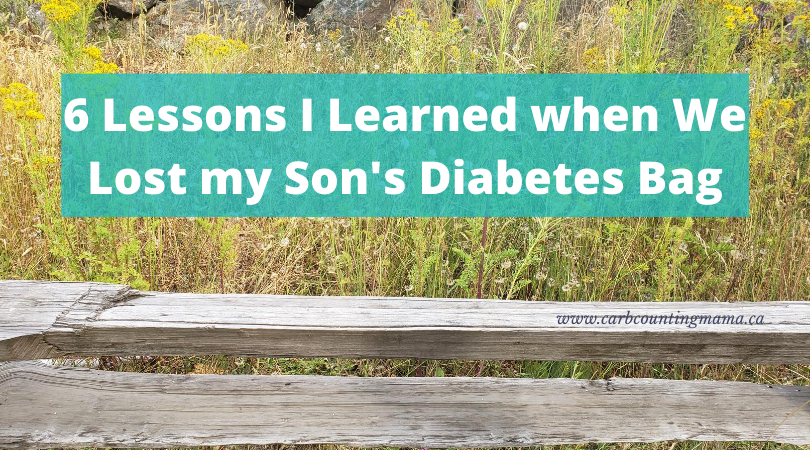

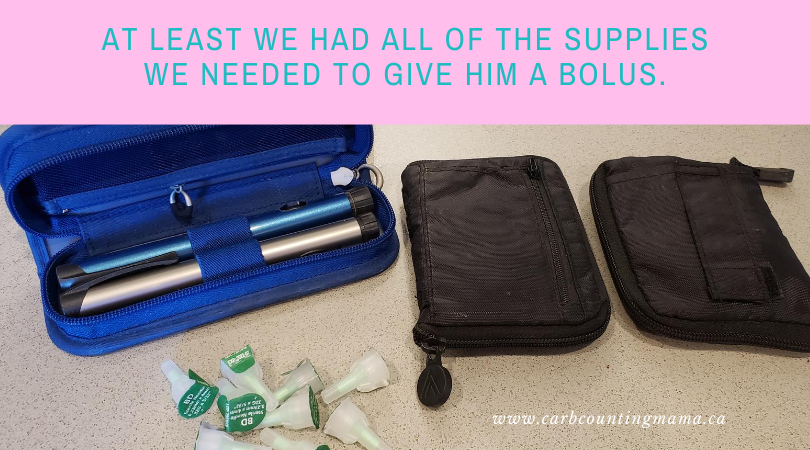
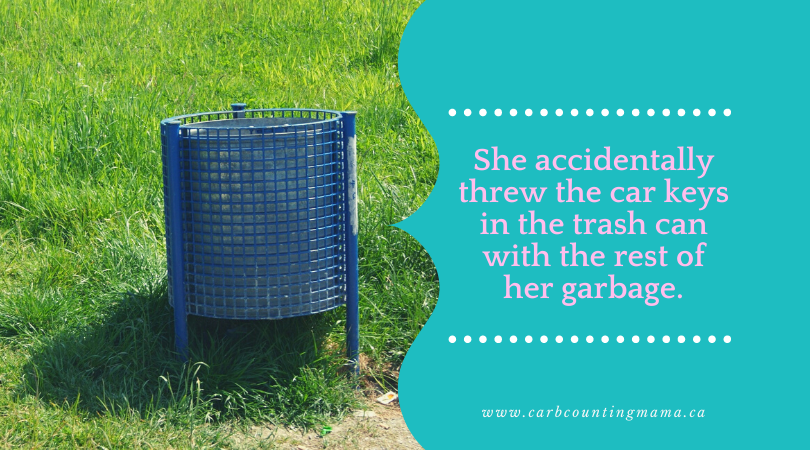
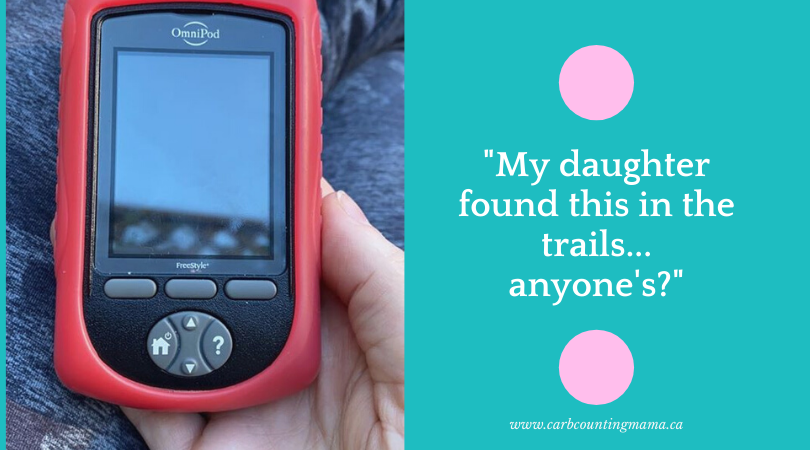
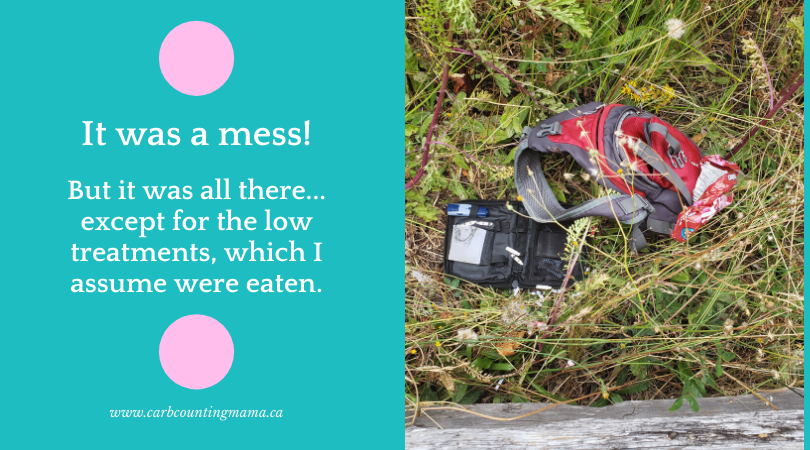
Leave a Reply